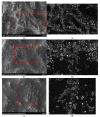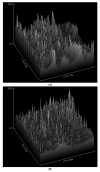Preparation and Characterization of Eco-Friendly Transparent Antibacterial Starch/Polyvinyl Alcohol Materials for Use as Wound-Dressing
- PMID: 35744574
- PMCID: PMC9231090
- DOI: 10.3390/mi13060960
Preparation and Characterization of Eco-Friendly Transparent Antibacterial Starch/Polyvinyl Alcohol Materials for Use as Wound-Dressing
Abstract
In this study, eco-friendly and transparent starch-based/polyvinyl alcohol/citric acid composite films are evaluated for their efficacy as wound dressing materials. The starch/polyvinyl alcohol (PVA) materials with added citric acid (0.46-1.83 wt%) and glycerol were made and handled based on the modified casting method. This new formulation decreases the amount of PVA used in the conventional preparation method. Citric acid ensures an appropriate antibacterial environment for wound-dressing materials. The mechanical, chemical, and surface morphological properties of such films were assessed and analyzed by tensile strength tests, UV-Vis spectrometry, swelling index, and scanning electron microscopy (SEM). Furthermore, the water vapor transmission (WVT) quantity was measured for an ideal wound-healing process to investigate an optimal moisture environment around the wound bed. Moreover, the pH level of the dressings was measured to examine the possibility of bacterial growth around these starch-based films. Additionally, the films' in-vitro antibacterial activities were studied against the two most common Gram-positive and Gram-negative bacteria (Escherichia coli and Staphylococcus aureus). The new starch-based dressings demonstrated suitable degradation, antibacterial activity, fluid absorption, and adequate mechanical strength, representing wound-dressing materials' vital features.
Keywords: characterization; polyvinyl alcohol; starch-based films; surface morphology; transparent; ultrasound mixing; wound-dressing.
Conflict of interest statement
The authors declare no conflict of interest.
Figures















References
-
- Daunton C., Kothari S., Smith L., Steele D. A history of materials and practices for wound management. Wound Pract. Res. J. Aust. Wound Manag. Assoc. 2012;20
-
- Altaf F., Niazi M.B.K., Jahan Z., Ahmad T., Akram M.A., Safdar A., Butt M.S., Noor T., Sher F. Synthesis and characterization of PVA/starch hydrogel membranes incorporating essential oils aimed to be used in wound dressing applications. J. Polym. Environ. 2021;29:156–174. doi: 10.1007/s10924-020-01866-w. - DOI
Grants and funding
LinkOut - more resources
Full Text Sources
Miscellaneous

